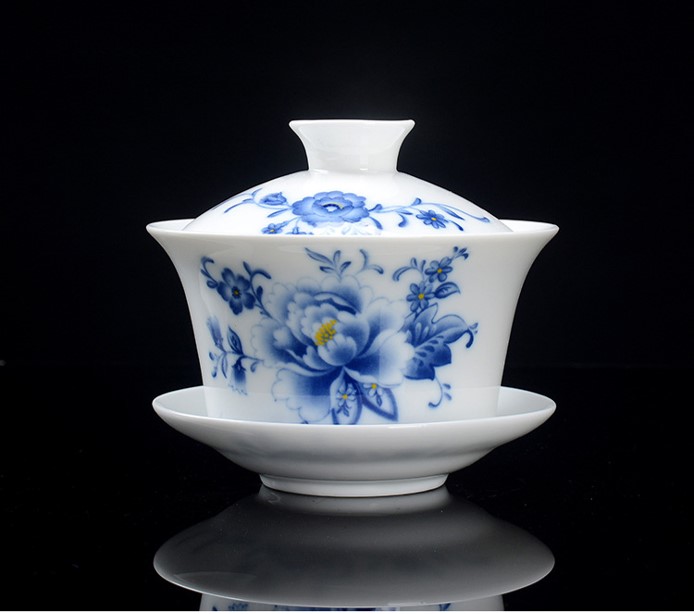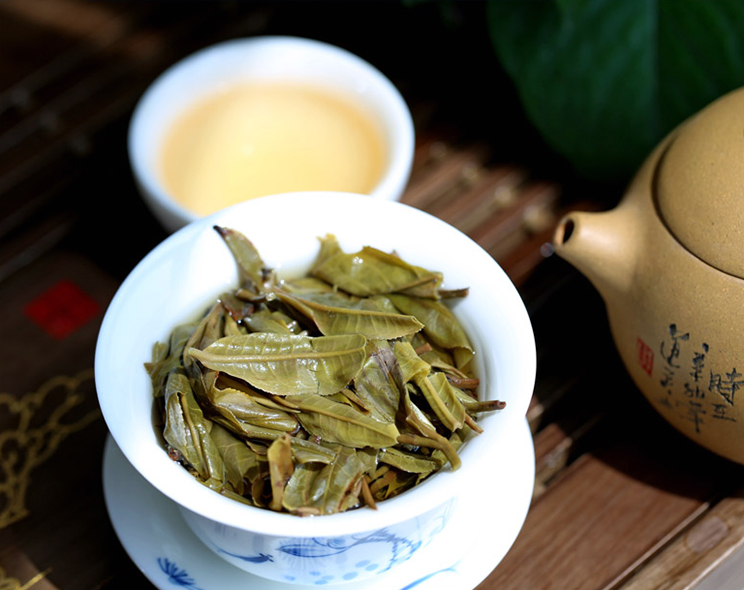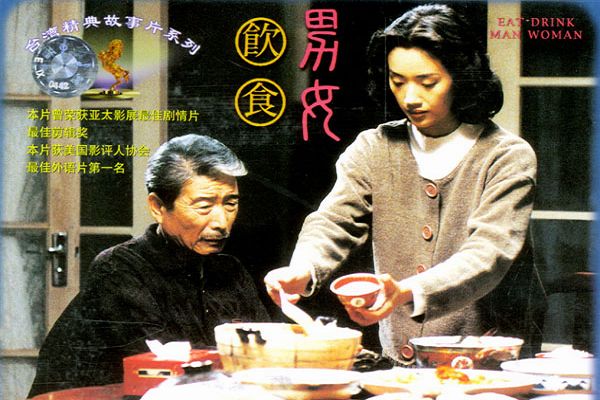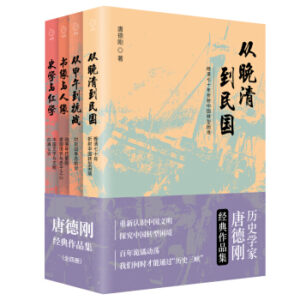Gaiwan (盖碗), literally meaning “lid and bowl”, is a traditional Chinese tea brewing and drinking vessel and is comprised of three parts including the lid, bowl, and saucer. According to traditional culture, the lid corresponds to the sky, the saucer corresponds to the earth, while the bowl corresponds to people. The design of Gaiwan expresses the meaning of unity and harmony among the three—sky, earth, and people. Before the Ming dynasty (1368 to 1644), the term for the versatile piece of tea equipment was Chawan (茶碗, “tea bowl”). During the Ming dynasty, when loose leaf teas came into fashion, the innovations of tea ritual and tea preparation gave rise to the Gaiwan. In terms of material, Gaiwan can be made from various materials including porcelain, glass, celadon, Yixing clay, or even jade. Because of its functionality, elegant simplicity, and ease of handling, Gaiwan is considered by tea lovers to be a universal tool in the preparation of tea. Here are four reasons for you to appreciate and use Gaiwan.

1. Applicability
Unlike Yixing teapot, which is usually recommended for a particular type of tea, Gaiwan can be used to brew all types of tea. Most of the Gaiwans are made from ceramic with a glazed inner surface that won’t absorb any flavor while brewing. You can use your Gaiwan to brew a fresh green tea today and an earthy Pu’er tea tomorrow without worrying about muddled flavors. If you are new to the tea world, especially if you are investigating Chinese teas, a Gaiwan makes it easy to taste a variety of different styles without investing in an extensive collection of traditional tea ware.
2. Visibility
Gaiwans allow tea connoisseurs to see how the tea leaves unroll in the cup and smell and taste the nuances of the tea. Watching the leaves open and unfurl is not only a way to gauge the strength of the current brew, but also a process of enjoying the tea making. The clear view also makes it easy to adjust steeping times and get the best flavor out of any tea. Gaiwan is good at telling the quality of tea due to its opening and glazed surfaces. The none-porous structure prevents altering the flavor and aroma of the tea during brewing. The lid of the Gaiwan allows the tea to be infused right in the bowl and either to be decanted into another container or to be drunk right from the bowl (traditionally using the lid to block the leaves for ease of consumption and are especially common in the north of China for enjoying scented teas like jasmine tea).

3. Controllability
Though look complex, Gaiwan is actually quite simple to use. The wide opening is an advantage for loading large leaves and cleaning out the leaves after brewing. Gaiwans are often favored by tea connoisseurs for brewing delicate teas because they offer tons of control over every aspect of the brewing process. Besides, the wide opening allows heat to dissipate when brewing lighter teas or can be covered with the lid to retain heat for dark teas. After the first brew, you can fan the Gaiwan lid in the air to notice the smell under the lid. You can also examine the aroma of the wet leaves. As you brew your tea multiple times, you can explore the change in flavor over multiple infusions.
4. Elegance
Though Gaiwans come in many different forms, the basic design is elegantly simple. A bowl for holding tea leaves as they steep, a lid for covering the bowl to keep heat, and a saucer for handling the bowl when it is hot. These three parts integrate into one utensil and symbolize harmony and unity. Without a handle or spout, a Gaiwan is more balanced in the hand than a teapot. In general, due to its versatility, ease of use, and the direct feedback you get being able to observe the tea while it infuses, Gaiwan is the first choice for you to start the tea journey.

Gongfu tea method
Usually, Gaiwan is closely related to the Gongfu tea method, a process of brewing and tasting several infusions in small cups that can maximize the taste. In a typical Gongfu tea ceremony, many tea accessories including brewing vessels, tea pitchers, brewing tray, tea strainer, tea holder, hot water kettle, and teacups are used. The regular process can be either complicated or simplified. For a daily tea routine, the process can go simple as this: add tea leaves to the teapot, followed by hot water, and decant your brew into the cup. When the first infusion is finished, continue for the subsequent infusions depending on the teas and occasions.

Here are three reasons for recommending the Gongfu tea method. Firstly, it can prevent over-brewing teas. Through short infusions and more brewing times, a small tea vessel can make strong and concentrated infusions, keep the natural flavor, and reduce bitterness. Secondly, it can get the most out of every leaf. All whole-leaf teas will yield flavor through at least three infusions. If you use a large mug, you can first brew the tea leaves in a smaller teapot, and then combine three infusions to fill into the mug. This process will draw the leaf open more slowly and create a better flavor for the same amount of tea leaves. Thirdly, it can train your palate. Drinking in a smaller volume can help tea drinkers train or refine their palate, as smaller cups encourage slow sips. Gongfu tea method will reveal different nuances that reflect details of each tea’s terroir, harvest date, or craftsmanship. This is why connoisseurs love to brew in this style, and also why tea vendors use this method to test the quality of every tea.
How to use Gaiwan?
- Warm Gaiwanwith hot water. This ensures better temperature control and cleans Gaiwan. Rinse the Gaiwan and drain.
- Measure tea leaves. How much tea to use will vary with the type of tea and size of your Gaiwan. For example, fill Gaiwan 20% full if using ball-rolled tea, and 60% full if using twist-rolled tea.
- Rinse the leavesbefore fully infusing. This releases the initial aroma and can begin the process of leaf-opening.
- Infuse leaves by pouring in water heated to the appropriate temperature for your specific tea. The temperature and infusion time vary among different teas.
- Pour and serve the tea by carefully picking up the Gaiwan. Two ways of holding Gaiwan and the way for a drink directly from Gaiwan are shown in the following part.
- Reinfuse. Many teas evolve with multiple infusions, and you’ll get to know your tea and at what stages you enjoy it best, by experimenting with this process.

Two ways of holding Gaiwan and way of a direct drink
The first way: overhand grip:
- Position the lid on a slight angle so that the tea can be poured out.
- Grasp the Gaiwan rim with your thumb and middle finger.
- User your index finger to hold the knob to keep the lid in place.
- Pour out your tea.

The second way: underhand grip:
- Position the lid on a slight angle so that the tea can be poured out.
- Pick up the Gaiwan with your non-dominant hand and place your four fingers except the thumb of your dominant hand under the Gaiwan.
- Use your thumb (dominant hand) to hold the knob to keep the lid in place.
- Pour your tea.

Drink directly from a Gaiwan:
- Pick up the whole Gaiwan using the saucer.
- Remove the lid and use it to slightly sweep leaves away from the spot closest to your mouth.
- Use the lid to hold the leaves back and take a sip.











